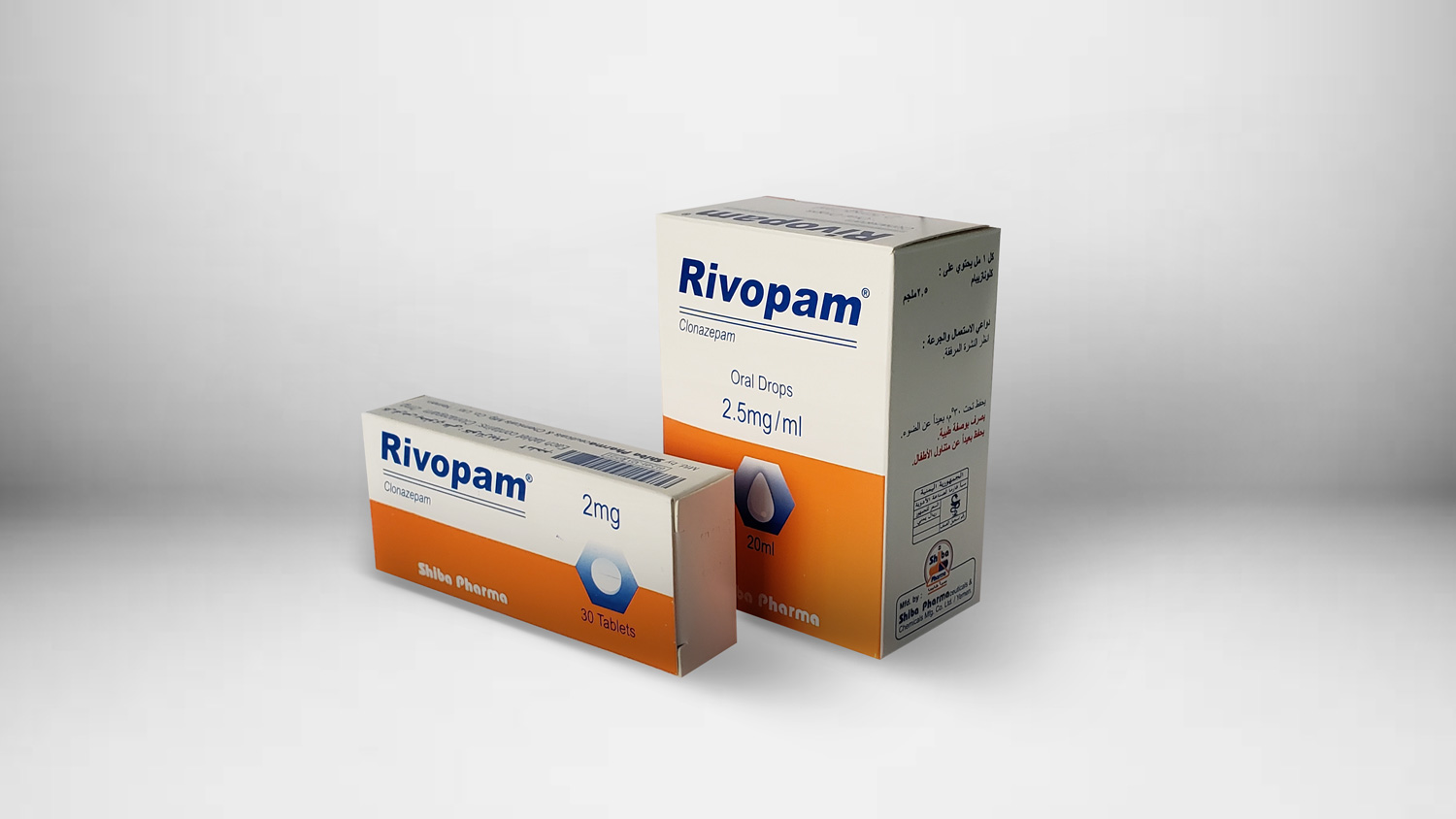Section :
Rivopam Drops & Tabs
COMPOSITION :
Each tablet contains : Clonazepam 2 mg.
Each Iml of oral drops contains =: Clonazepam 2.5 mg.
DESCRIPTION :
Rivopam (clonazepam ) belongs to a group of medicines called ‘benzodiazepines’. Rivopam enhances the activity
of the inhibitory action neurotransmitter Gamma-Aminobutyric acid (GABA) , that is the major inhibitory
neurotransmitter in the central nervous system . It acts by binding to the benzodiazepine site of the GABA
receptors and decreasing any excessive electrical nerve activity in the CNS that might be contributing to seizures ,
this inhibition lead to anticonvulsant, skeletal muscle relaxant, and anxiolytic effects.
INDICATIONS :
Rivopam is used to treat :
- Epilepsy in infant, children and adult.
- Panic disorders with or without agoraphobia.
DOSAGE & ADMINISTRATION :
It is used with the lowest dose and period as possible. The dosage of Rivopam must be individually adjusted
according to the patient’s clinical response and tolerance. In order to minimise initial adverse reactions, it should
- Do not take a double dose (two doses at the same time) to make up for a forgotten dose.
Seizure Disorders:
Infants up to 12 months: the initial dose is 0.25 mg per day or less, and the dose is gradually increased to 0.5 to 1.0 mg per day.
Children from 1 to 5 years: the initial dose is 0.25 mg per day or less, and the dose is gradually increased to 1 to 3 mg per day.
Children from 5 to 12 years: the initial dose is 0.5 mg per day or less, and the dose is gradually increased to 3 to 6 mg per day.
Adults and children over 12 years of age: the initial dose is 1 mg per day or less, and the dose is gradually increased to 4 to 8 mg per day.
Elderly people 65+: The initial dose is 0.5 mg per day or less, and the dose is gradually increased to 4 to 8 mg per day . max does 20 mg.
Panic disorders:
- Children: There is no clinical trial experience in panic disorder patients under 18 years of age.
RESTRICTIONS ON USE :
Contraindications
-Hypersensitivity to Clonazepam or to Other ‘benzodiazepine’ medicines
- Dependance on medication
- Patients with myasthenia gravis, acute narrow angle glaucoma
Precautions
The caution should be taken in patient with:
- severe liver damage, porphyria (abnormal haemoglobin metabolism).
- Acute intoxication due to alcohol, sleep apnea
* If the dose of Rivopam has to be reduced or stopped, this must be done gradually to avoid withdrawal symptoms.
Use in pregnancy and lactation
Rivopam should only be administered to pregnant women if the potential benefits outweigh the risk to the fetus,
it is known that Rivopam has harmful effects on unborn child. It should not be used during breast feeding.
Driving and using machines
The patient should be informed that this medicaction may impaire the ability to drive a vehicle or operate
machine, so driving and using machine and other hazardous activities should therefore be avoided altogether or at
least during the first few days of treatment.
DRUG INTERACTIONS :
The caution should be taken when coadministration of Rivopam with the following drugs:
- Opioids or CNS depressant may result in profound sedation, respiratory depression, coma, and death.
ADVERSE EFFECTS :
Clonazepam as other benzodiazepine drugs cause adverse effects , but not every patient get them :
- In infant and small children: increase production of saliva and bronchial hypersecretion.
OVERDOSAGE:
Overdosage of benzodiazepines is usually ranges from drowsiness to coma. In mild cases, symptoms include
drowsiness, mental confusion and lethargy. In more serious cases, symptoms may include ataxia, dysarthria,
nystagmus, hypotonia, hypotension, respiratory depression, coma and very rarely death.
Treatment: Maintain a clear airway and adequate ventilation if indicated.
Symptomatic treatment for cardiorespiratory or central nervous system effect, treatment with activated charcoal
within 1-2 hours. Gastric lavage in case of mixed overdose where no more than one hour has elapsed since
ingestion.
If CNS depression is severe consider the use flumazenil only be administered under closely monitoring .
Hemoperfusion and hemodialysis are not useful in benzodiazepine intoxication.
STORAGE INSTRUCTIONS :
Store below 30°C, away from light.
PRESENTATIONS :
Rivopam tablets : Pack of different sizes.
Rivopam oral drops : Pack of 20 ml .


